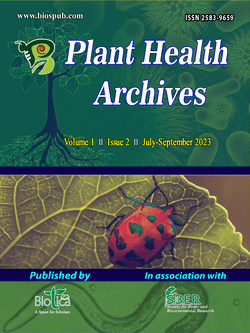
Study on Diversity of Fungus Associated with Nephila pilipes
Jalajakshi, S.*
Dept. of Genetics, Vijaya College, Basavanagudi, Bengaluru, Karnataka (560 004), India
Anagha, J.
Dept. of Genetics, Vijaya College, Basavanagudi, Bengaluru, Karnataka (560 004), India
Buwaneshwari, S.
Dept. of Genetics, Vijaya College, Basavanagudi, Bengaluru, Karnataka (560 004), India
Kalpana, R.
Dept. of Genetics, Vijaya College, Basavanagudi, Bengaluru, Karnataka (560 004), India
Poojitha, P.L.
Dept. of Genetics, Vijaya College, Basavanagudi, Bengaluru, Karnataka (560 004), India
Sowmya Murthy
Dept. of Genetics, Vijaya College, Basavanagudi, Bengaluru, Karnataka (560 004), India
DOI: https://doi.org/10.54083/PHA/1.2.2023/14-17
Keywords: Biodiversity, Conidia, Conidiophore, Fungi, Hyphae, Nephila pilipes
Abstract
The fungus has various type of association with spider. They can be pathogenic or symbiotic or commensal in relationship to spiders they live on. In the current study the diversity of fungi in association with Nephila pilipes spider were recorded. The fungi were isolated from its legs and saliva. The microscopic and macroscopic characters were obtained. The measurements of hyphae, conidia and conidiophore were recorded. The fungal growth was more on legs compared to saliva. The legs of the adult spider carried more fungi than saliva as they are associated with soil, carrying microflora on their legs. Further the four different fungus isolated as Aspergillus, Penicillium, Trichoderma and Cladosporium. The penicillium colony had abundant growth, aspergillus had moderate growth and Cladosporium had less growth compared to Trichoderma.
Downloads
not found
Reference
Atlas, R.M., Parka, L.C., 1997. Handbook of Microbiological Media. 2nd Edition. CRC Press, Boca Raton. p. 1706.
Benson, H.J., 2005. Benson’s Microbiological Applications: Laboratory Manual in General Microbiology. 9th Edition. McGraw-Hill Higher Education, Boston. p. 525.
Cappuccino, J.G., Welsh, C., 2017. Microbiology: A Laboratory Manual. Global Edition, 11th Edition. Pearson Education. p. 560.
Carris, L.M., Little, C.R., Stiles, C.M., 2012. Introduction to Fungi. In: The Plant Health Instructor. American Phytopathological Society, St. Paul, USA. DOI: 10.1094/PHI-I-2012-0426-01.
Cooke, W.M.B., 1954. The use of antibiotics in media for the isolation of fungi from polluted water. Antibiotics and Chemotherapy 4(6), 657-662.
Dugan, F.M., 2017. Hosts, substrata and environments. In: The Identification of Fungi: An Illustrated Introduction with Keys, Glossary and Guide to Literature. American Phytopathological Society, St. Paul, USA. pp. 120-122. DOI: 10.1094/9780890545041.008.
Ezz, N.A., 2012. Entomopathogenic fungi associated with certain scale insects (Hemiptera: Coccoidea) in Egypt. Egyptian Academic Journal of Biological Sciences (A. Entomology) 5(3), 211-221. DOI: 10.21608/EAJBSA.2012.14287.
Gaddeyya, G., Niharika, P.S., Bharathi, P., Kumar, P.K.R., 2012. Isolation and identification of soil mycoflora in different crop fields at Salur Mandal. Advances in Applied Science Research 3(4), 2020-2026.
Hauser, J.T., 2013. Techniques for Studying Bacteria and Fungi. Carolina Biological Supply Company, Burlington. p. 31.
Jalajakshi, S., Usha, R.N., 2019. Phylogenetic analysis of cox I gene in identification of spiders. Journal of Entomology and Zoology Studies 7(2), 895-897.
Jarvis, B., 1973. Comparison of an improved Rose Bengal-Chlortetracycline Agar with other media for the selective isolation and enumeration of moulds and yeasts in foods. Journal of Applied Bacteriology 36(4), 723-727. DOI: 10.1111/j.1365-2672.1973.tb04157.x.
Knogge, W., 1996. Fungal infection of plants. The Plant Cell 8(10), 1711-1722. DOI: 10.1105/tpc.8.10.1711.
Ottow, J.C., 1972. Rose Bengal as a selective aid in the isolation of fungi and actinomycetes from natural sources. Mycologia 64(2), 304-315.
Papavizas, G.C., Davey, C.B., 1959. Evaluation of various media and antimicrobial agents for isolation of soil fungi. Soil Science 88(2), 112-117. DOI: 10.1097/00010694-195988020-00010.
Smith, N.R., Dawson, V.T., 1944. The bacteriostatic action of Rose Bengal in media used for plate counts of soil fungi. Soil Science 58(6), 467-471. DOI: 10.1097/00010694-194412000-00006.
Sun, J.M., Irzykowski, W., Jedryczka, M., Han, F.X., 2015. Analysis of the genetic structure of Sclerotinia sclerotiorum (Lib.) de Bary populations from different regions and host plants by Random Amplified Polymorphic DNA markers. Journal of Integrative Plant Biology 47(4), 385-395. DOI: 10.1111/j.1744-7909.2005.00077.x.
Waksman, S.A., 1922. A method for counting the number of fungi in the soil. Journal of Bacteriology 7(3), 339-341. DOI: 10.1128/jb.7.3.339-341.1922.
